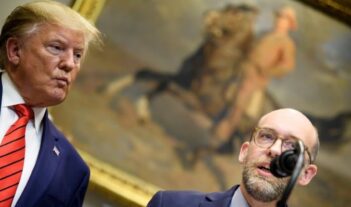
Regulators need a new system for responding to evolving market forces.
In the late 1930s, New York Mayor Fiorello LaGuardia signed a law requiring all city taxicab operators to hold an officially-issued medallion. In recent years, the efforts of New York and other major cities to continue regulating the taxicab market have become highly controversial. Uber, Lyft, and other ridesharing companies have managed to work around this outdated system, arousing the ire of cab drivers. At first glance, the old medallion laws appear to be nothing more than a naked restraint of commerce, privileging incumbent firms at the expense of innovative new entrants. And indeed, artificially limiting supply and thereby inflating prices almost certainly was and continues to be one of the primary motivations for erecting and maintaining this system.
Nevertheless, defenders of the status quo have also pointed to a more benign motivation for regulation: prospective riders may not be able to judge the quality or safety of potential drivers, a problem that standardization helps remedy. To put it in economic terms, this is an instance of information asymmetry, one of the classic market failures calling for government intervention.
Had market forces not evolved since the late 1930s, this argument would likely carry some weight. Yet, as anyone who has ever used Uber or Lyft is aware, the sophisticated user-feedback mechanisms these apps offer have substantially mitigated, if not completely eliminated, the information asymmetry problem. One seldom encounters disgruntled Uber riders wishing they had taken a cab instead.
This simple example illustrates a fairly profound problem in regulatory policymaking: market failures are often temporary, and regulations that once made eminent sense can become anachronistic as technology evolves. The traditional assumption has been that more regulation is needed as the economy grows more complex. Although that is likely true in certain contexts—for example, the U.S. Securities and Exchange Commission must update its regulations as complex new financial instruments emerge—the opposite trend also exists, because shifting market forces have the potential to remedy erstwhile market failures.
In this sense, it is worthwhile to sort regulatory interventions into two major categories. Some permanent interventions may be necessary to remedy inherent market flaws and channel economic activity in a productive direction. For instance, few would question the constant need for some system of governmentally-created intellectual property rights (even though, of course, reasonable minds might differ as to how long and protective those rights need to be to support innovation). Other regulatory interventions, however, might be more temporary, perhaps even analogized to a catalyst in a chemical reaction which is needed in order to kick off a process that leads to a desired outcome but becomes unnecessary or even detrimental once the intended reaction has occurred. Regulations of this latter type can become outmoded and counterproductive as market conditions or technologies evolve.
The challenge, of course, lies in distinguishing the two types of interventions. A robust benefit-cost analysis will help regulators determine whether they should act now, but it tells them little to nothing about what to expect in the future. The obvious solution is to implement some system of retrospective review: regulatory agencies should periodically revisit their existing rules to determine if they still make sense, and Congress should do the same for its statutes.
Sadly, this is much easier said than done. Regulators have very little incentive to upset their own handiwork, and they may not have a good sense of how their regulations interact with those of other agencies to impose a significant cumulative burden. Congress suffers from this even more, since it does not typically prepare a benefit-cost analysis when adopting new laws, to say nothing of retrospectively reassessing the economic effects of existing statutes. Regulated entities also may have weak incentives to push for any change in the status quo, as they often have incurred the large initial costs to come into compliance with regulations. These existing businesses may dread the prospect of new market entrants not having to make those same investments.
How, then, might one design a regulatory regime to ensure that this critical function takes place? One possibility is shifting the underlying incentives to force retrospective review. Two recent executive orders signed by President Donald Trump, Executive Orders 13,771 and 13,777, do just that by effectively imposing a limit on both the numbers and costs of new regulations. These initiatives apply only to regulations and therefore are not responsive to similar problems created by outdated statutes. Also, on the regulatory front, there is always the risk that the wrong regulations will be eliminated. At the very least, the regulatory task forces created by Executive Order 13,777 should seek input from a wide array of stakeholders in determining which rules to revise or eliminate. In so doing, the task forces should especially focus on obtaining input from consumer groups and small businesses, whose input might otherwise be crowded out by beneficiaries of the status quo.
Another potential approach is attempting to promote a more experimental model of regulatory policymaking. The gold standard would involve erecting the regulatory equivalent of clinical drug trials, assigning different entities to regulatory “treatments” and assessing the results. As Professor Zachary Gubler has noted in a series of recent articles, this approach is highly attractive in theory, but faces a number of practical roadblocks. Most importantly, it is unclear how a reviewing court would respond to a regulatory model that by its very design suggests that the agency lacks sufficient information to select an optimal intervention. Businesses may also prefer the certainty associated with an agency settling on a definitive position, even if the resulting regulatory burden is somewhat heavier than what would eventually emerge from a regulatory experiment.
Agencies can also look for other opportunities to promote regulatory learning. The Administrative Conference of the United States recently encouraged agencies to do precisely that, issuing a recommendation on “Learning from Regulatory Experience.” Among other things, this recommendation encourages agencies to engage in “quasi-experiments,” carefully comparing parties subject to different regulatory treatments to attempt to isolate the effects of regulation. This might entail comparing firms that are slightly above and slightly below a regulatory threshold or analyzing the comparative performance of businesses that have obtained regulatory waivers and those that have not. Although less controversial than a randomized control trial, these approaches might also raise equity concerns, especially if the agency applies differing regulatory treatments merely to compare outcomes. And, as with retrospective review more generally, agencies may lack the incentives and institutional capacities to seek out and act upon such learning.
A final approach may entail handing back more regulatory power to the states and localities, creating a natural experiment of the type described by Justice Louis Brandeis in New State Ice Co. v. Liebmann. Interestingly, this is precisely what is happening in the ridesharing context. For instance, Uber and Lyft both temporarily pulled out of the Austin, Texas market in response to efforts of city officials to impose regulations similar to those applicable to cab drivers. When states and localities function as “laboratories of democracy,” both businesses and citizens can “vote with their feet” if they object to the particular regulatory package (or lack thereof) selected by their state and local leaders.
Of course, reliance on state and local regulation triggers the classic objection to any decentralized system of policymaking, namely, that it sets off a regulatory “race to the bottom.” Although this is certainly a legitimate concern, a “race to the bottom” may be a good thing if it involves the erosion of an outmoded, inefficient regulatory regime, as is currently playing out in the taxicab market. And just as businesses can move to a state or city that imposes weaker regulatory restrictions, individual citizens can move away from a jurisdiction that does not provide public safety protections they deem adequate. In short, although the costs associated with enhanced federalism in the regulatory space are real, there are also enormous benefits that should not be overlooked.
Ultimately, there is no easy way to design a regulatory system that can respond to evolving market forces. Yet any effort to do so is likely to yield enormous dividends, given the current political impasse associated with regulatory policymaking. At present, conservatives (understandably) oppose any new regulatory intervention for fear it will become irreversible. Progressives (also understandably) oppose any deregulatory effort for fear that many good regulations will get swept up with the bad ones. In theory, both sides should support a regulatory system designed to correct legitimate market failures and to readjust the level of intervention as the market evolves. Actually achieving that result, however, is likely to prove enormously complicated and will require policymakers to approach their task with a fresh perspective. Each of the options considered above holds some promise and faces certain drawbacks. Regulators must be willing to consider these and other innovative solutions if they are to construct a more dynamic regulatory system.
This essay is part of an eight-part series, entitled New Developments in Regulatory Benefit-Cost Analysis.




